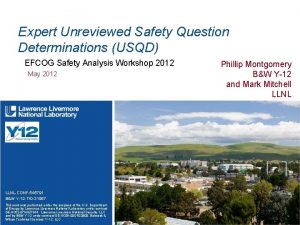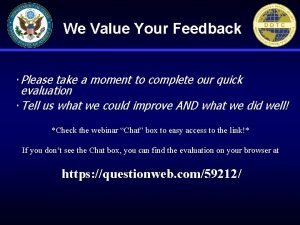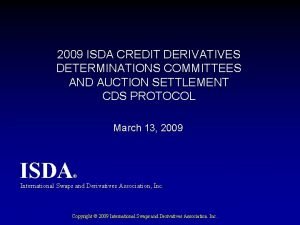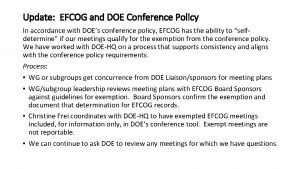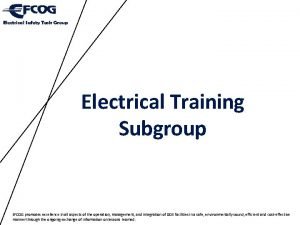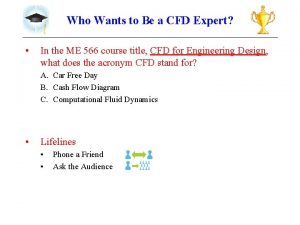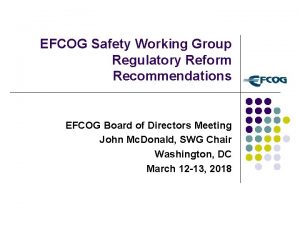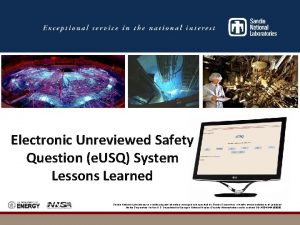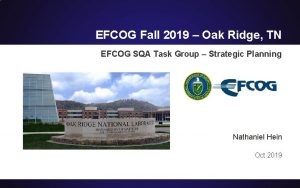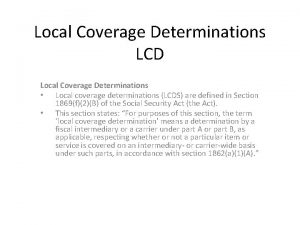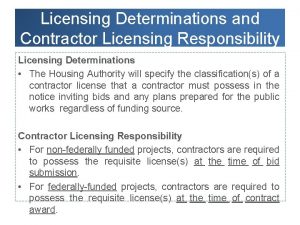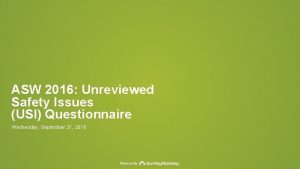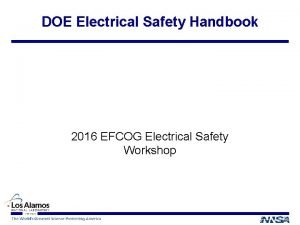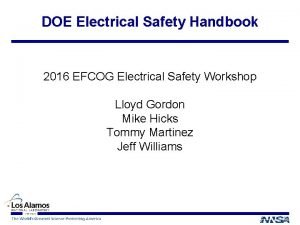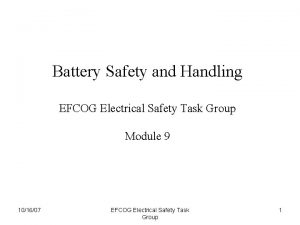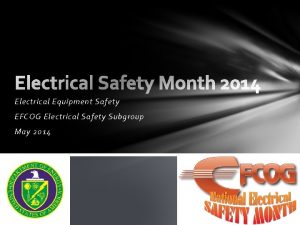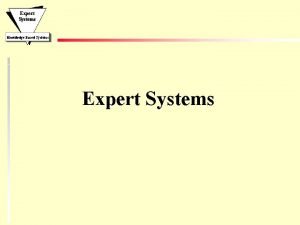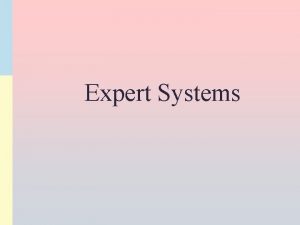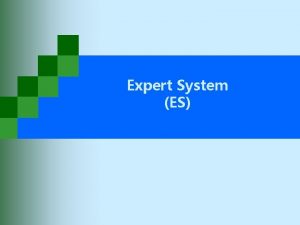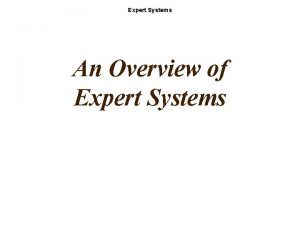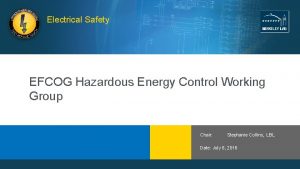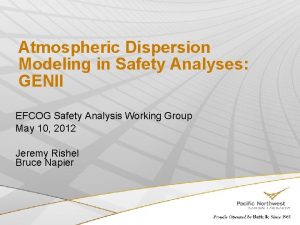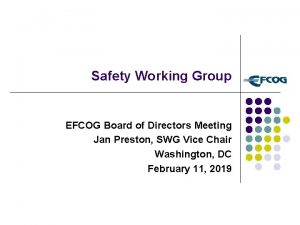Expert Unreviewed Safety Question Determinations USQD EFCOG Safety





















- Slides: 21

Expert Unreviewed Safety Question Determinations (USQD) EFCOG Safety Analysis Workshop 2012 May 2012 LLNL-CONF-545791 B&W Y-12 -TIO-31957 This work was performed under the auspices of the U. S. Department of Energy by Lawrence Livermore National Laboratory under contract DE-AC 52 -07 NA 27344, Lawrence Livermore National Security, LLC and by B&W Y-12 under contract DE-AC 05 -00 OR 22800, Babcock & Wilcox Technical Services Y‑ 12, LLC. Phillip Montgomery B&W Y-12 and Mark Mitchell LLNL

LLNL & Y-12 Expert USQD Pilots = Success! • LLNL Expert USQD Pilot Successful – All review criteria MET – Expert USQDs constituted 32% of all USQDs – Pilot included a sample of 204 USQDs • 65 Expert USQDs • 139 standard USQDs. • Y-12 Expert USQD Pilots Successful • Path forward – LLNL: Fully implemented • Expert USQD Effectiveness Review Plan includes continued review of 100% of Expert USQDs for 1 st year of implementation • Further pilots at LLNL are unnecessary – Y-12: Fully implemented – Other sites considering Expert USQD Process 2

Agenda • Background: USQ Process • Purpose of Expert USQD • Expert USQD: EFCOG, NNSA, Y-12, and LLNL – – LLNL Expert USQD Pilot • LLNL Expert USQD Pilot Review Criteria • Expert USQDs by Type of Change • Utilization of Expert USQDs in comparison to standard USQDs for each nuclear facility/activity • Expert USQD: Measuring Success at LLNL • Conclusion: LLNL Expert USQD Pilot = Success! Y-12 Expert USQD Process • Pilots - stats • Current Status • “Expert USQD”: Process Improvement at Y-12 • “Expert USQD”: Measuring Success at Y-12 • “Expert USQD”: Performance & Path Forward • USQ Process: Overall Path Forward 3

Background: USQ Process • USQDs require significant resources to prepare, review, and approve – Y-12 averages over 1100 USQDs per year (10 nuclear facilities) – LLNL typically 450 USQDs per year (6 nuclear facilities) • Recognized need to streamline USQ process across DOE Complex, great opportunity to become more efficient – Series of off sites started in 2006, by Phil Montgomery (USQ SME), David Sheffey (Compliance Manager) and Kevin Carroll (Safety Analysis Department Head), aimed at improving efficiency of USQ process • Resulted in a new approach to reducing the # of Std. USQDs - Development of Expert USQD concept – 10 CFR 830. 203 requires a DOE-approved USQ Process – Expert USQD Process not specifically discussed in DOE USQ Guide • Required DOE review and approval • Y-12, working with LLNL and EFCOG, developed Expert USQD Process, facilitate discussions across DOE Complex , and obtained buy-in from CDNS, CNS, HSS, etc. • D’Agostino (NA-1) approval was requested and obtained • Y-12 conducted Expert USQD Pilot, sharing lessons learned with LLNL • LSO approved LLNL Expert USQD Process • LLNL piloted Expert USQD Process 4

Purpose of Expert USQD • Quickly determine, with minimal documentation, that a change is not a USQ (i. e. , positive USQD) • The intent is for Expert USQDs to be used as an efficiency measure when 1. Negative USQD readily apparent to experienced USQD personnel (Experts) 2. Conclusion easily and succinctly explained to someone familiar with facility • Expert USQD Process limits preparation and review of Expert USQDs to a limited set of highly trained and experienced Experts who have experience in their facility 5

Expert USQD: EFCOG, NNSA, Y-12, and LLNL • Presented process and pilot data at EFCOG SAWG conferences – – Incorporated comments from CDNS, CNS, DOE, DNFSB staff, SAWG, and others Published in NNSA Technical Bulletins • Approved by NNSA Administrator, D’Agostino • Published by EFCOG as a Best Practice – EFCOG Best Practice 109, Application of Expert USQDs to Expedite the USQ Process, based on Y-12 Expert USQD Process and EFCOG SAWG Recommendations White Paper to Improve the Unreviewed Safety Question (USQ) Process http: //www. efcog. org/bp/p/109. htm Note that this best practice paper includes training material and examples to support implementation of the Expert USQD process 6

LLNL Expert USQD Pilot • Review Expert USQDs completed during 6 month trial period (Pilot) • All Expert USQDs prepared during Pilot reviewed for compliance with LLNL USQ Procedure • Pilot is a requirement of NNSA/LSO and NNSA Administrator Thomas D’Agnostino in NA-1 approval of Expert USQD process • LLNL Expert USQD process was approved on June 15, 2011, and implemented September 13, 2011 • Review Team: LLNL USQ SME, Safety Basis Division Institutional Reviewer of Superblock, and Safety Basis Deputy Division Leader 7

LLNL Expert USQD Pilot Review Criteria Questions answered during this monitoring activity: 1. Is the Expert USQD process being utilized? If so, is it being utilized properly? a. Have the requirements of ES&H Manual Document 51. 3 been met? i. Has the Facility Manager (or designee) approved the Expert USQD Preparers and Reviewers for his or her facility? ii. Has the Safety Basis Division Leader (or designee) concurred with the designation of Expert USQD Preparers and Reviewers? iii. Has the Safety Basis Division Leader (or designee) evaluated the performance of the Expert USQD Preparers and Reviewers? iv. Do the Expert USQD Preparers and Reviewers meet the qualification requirements of Section 5. 12? v. If Expert USQDs were conducted, do they meet the requirements of ES&H Manual Document 51. 3? vi. Was the official Expert USQD form in ES&H Manual Document 51. 3 used properly? vii. Are Expert USQDs being tracked in a manner that facilitates their inclusion on the annual list of USQDs submitted to DOE? 8

LLNL Expert USQDs by Type of Change 3; 5% 10; 15% Procedure Revision Baseline USQD Physical Change 52; 80% Type of change Sub-Type Procedure Revision Procedure Baseline USQD Physical change New activity/test/operation Total New Operation Number 62 10 Percent of Total 95% 15% 52 80% 3 0 65 3% 0% 100% 9

LLNL Utilization of Expert USQDs in Comparison to Standard USQDs by Type 65; 32% Expert USQD standard USQD 139; 68% Type of USQD Number Expert USQD 65 Percent of Total 32% Standard USQD 139 68% Total 204 100% 10

LLNL Utilization of Expert USQDs 80 60% 70 50% 60 40% 50 Total Expert USQDs 40 30% Total USQDs % Expert USQDs 30 20% 20 10% 10 0 0% B 239 B 331 B 332 B 334 WSF PATS Expert USQD 8 11 13 10 20 3 Total USQDs 23 36 69 32 38 6 31% 19% 31% 53% 50% % Expert USQDs 35% 11

Expert USQD – Measuring Success at LLNL • Compliance to requirements – – Expert USQD Process expedited USQ process while remaining Compliant All LLNL nuclear facilities/activities successfully completed Pilot without a Finding • No non-compliant Expert USQDs, i. e. , no Expert USQD prepared when a standard USQD was appropriate All review criteria were successfully MET LLNL Expert USQD Process is considered a best practice across DOE Complex as documented in the EFCOG best practice paper which DOE and contractors are using as basis for implementation • Efficiency Improvements – Improved responsiveness of USQ Process to rushes and turnaround time • Degree of Implementation – – – Sample of 204 USQDs • 65 Expert USQDs (32%) • 139 standard USQDs (68%) LLNL typically prepares 450 USQDs per year Valid sampling showing good utilization of Expert USQD Process 12

Conclusion: LLNL Expert USQD Pilot = Success! • Expert USQD Pilot successful – All review criteria MET – Expert USQDs constituted 32% of all USQDs – Pilot evaluation was representative • Path forward – Further pilots at LLNL are unnecessary – Expert USQD Effectiveness Review Plan includes continued review of 100% of Expert USQDs for 1 st year of implementation 13

Y-12 Expert USQD Process • Expert process not specifically discussed in DOE G 424. 1 -1 B, Implementation guide For Use In Addressing Unreviewed Safety Question requirements – New approach required DOE review and approval • Y-12 completed parallel pilots in two Y-12 facilities (2009 -2010) • Y-12 fully implemented the Expert USQD process late 2010 Y-12 Pilot Data Expert USQDs were written for: • 60% of all Procedure Changes • 42% of all Physical changes • 51% of all changes 14

Expert USQD: Process Improvement at Y-12 • FY 2011 - 1 st year of site-wide implementation – 30% Expert USQD utilization (353 EUSQDs) • FY 2012 – 43% Expert USQD Utilization (1 st six months, 237 EUSQDs) 70% Y-12 FY 2012 Expert USQD Utilization 60% 50% 45% 41% 43% 42% 43% 40% Avg. Y-12 FY 2011 Expert USQD Utilization 30% 20% 54% 42% 46% 41% 38% 33% % by Month 9/12 8/12 7/12 6/12 5/12 4/12 3/12 2/12 12/11 0% 11/11 10% 10/11 % EUSQDs 42% % YTD AVG 15

Expert USQD: Measuring Success at Y-12 Success was gauged by multiple measures: • Compliance – Are the documents compliant with the Y-12 Expert USQD Process? (Y 74 -809 Pilot & Y 74 -809) • Pilots included 100% review • Full implementation reviews: 100% the first year – Second year phased into periodic management assessments and Y-12 Site Office (YSO) reviews • Assessment Results – No significant issues from assessments by DOE or contractors – To date, eight assessments were conducted at Y-12 (six by B&W Y-12 and two by the NNSA) 16

Expert USQD: Measuring Success at Y-12 Success was gauged by multiple measures (cont. ) • Efficiency Improvements – Is the new process more efficient? • Simple one-page form for certain types of changes compared to typical eightpage form for standard USQDs • Designated “Experts” quickly complete Expert USQDs vs. longer time for standard USQDs • Better utilization of limited resources to work on higher priority tasks • Degree of implementation • Anticipated 30 – 50% utilization based on preliminary study prior to pilots – Pilots resulted in 51% – Year 1, yielded 30% – Year 2, to date 43% 17

Conclusion: Y-12 Expert USQD Pilot & Implementation = Success! • Expert USQD Pilot and full implementation successful – – Assessment results indicated a very high degree of compliance Expert USQDs constitute 43% of all USQDs this FY to date Comparison data shows pilot evaluations were representative Y-12 anticipated benefits are approximately $1. 2 M/yr. • Y-12 Path Forward – Maintain integrity and continuous improvement of Expert USQDs • Incorporate beneficial feedback – User suggestions, including DOE complex-wide input – Customer needs – Assessment OFIs and Issues • Assist other site’s Expert USQD implementation efforts 18

USQ Process: Overall Path Forward • In addition to Y-12 & LLNL, Expert USQ Processes are being considered, developed, or implemented at other sites across the DOE Complex: – ORNL – LANL – Others • EFCOG SAWG USQ Subgroup believes that the Expert USQD process will effectively streamline the USQ process while maintaining the necessary rigor to ensure the proposed activities that require DOE approval, obtain that approval 19

USQ Process: Overall Path Forward • Other USQ Process improvement initiatives by SAWG’s USQ Subgroup – Providing input to DOE document revision process so as to improve interfaces and application of the USQ Process • 10 CFR 830. 203, Unreviewed Safety Question Process • DOE-STD-3009, Criteria and Guidance for Preparation of U. S. Department of Energy Nonreactor Nuclear Facility Documented Safety analyses • NNSA Technical Bulletins • HSS Paper • Others – Continue collaborating with DOE’s National Training Center in developing a standardized USQ Process Training Course • Training has now been conducted at three sites (NTC, NNSS, Savannah River) • Contact the authors for more information on forthcoming classes – Sharing Expert USQD and other implementation experiences within the EFCOG community to minimize issues 20

Disclaimer DISCLAIMER This work of authorship and those incorporated herein were prepared by Contractor as accounts of work sponsored by an agency of the United States Government. Neither the United States Government nor any agency thereof, nor Contractor, nor any of their employees, makes any warranty, express or implied, or assumes any legal liability or responsibility for the accuracy, completeness, use made, or usefulness of any information, apparatus, product, or process disclosed, or represents that its use would not infringe privately owned rights. Reference herein to any specific commercial product, process, or service by trade name, trademark, manufacturer, or otherwise, does not necessarily constitute or imply its endorsement, recommendation, or favoring by the United States Government or any agency or Contractor thereof. The views and opinions of authors expressed herein do not necessarily state or reflect those of the United States Government or any agency or Contractor thereof. COPYRIGHT NOTICE This document has been authored by contractors of the U. S. Government under contract DE-AC 05 -00 OR-22800 and DE-AC 52 -07 NA 27344. Accordingly, the U. S. Government retains a paid-up, nonexclusive, irrevocable, worldwide license to publish or reproduce the published form of this contribution, prepare derivative works, distribute copies to the public, and perform publicly and display publicly, or allow others to do so, for U. S. Government purposes. 21
 Usqd
Usqd Commodity jurisdiction final determinations
Commodity jurisdiction final determinations Isda determinations committee
Isda determinations committee Efcog
Efcog Efcog
Efcog Efcog best practices
Efcog best practices Efcog
Efcog Costas level questions
Costas level questions Present simple question words
Present simple question words Closed question example
Closed question example Contoh open ended question
Contoh open ended question Factor naming questions
Factor naming questions Indirect question
Indirect question Compelling vs supporting questions
Compelling vs supporting questions Compelling question meaning
Compelling question meaning Safety contour safety depth
Safety contour safety depth Safety care certification
Safety care certification Process safety vs personal safety
Process safety vs personal safety Safety assessment for ind safety reporting
Safety assessment for ind safety reporting Basic safety construction site safety orientation
Basic safety construction site safety orientation Basic safety construction site safety orientation
Basic safety construction site safety orientation Cfd expert
Cfd expert
